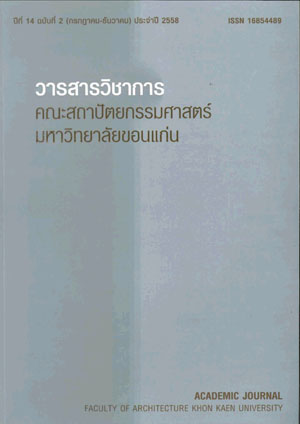กรอบแนวคิดการออกแบบบ้านพักชั่วคราวสำหรับผู้ประสบภัยแผ่นดินไหว
คำสำคัญ:
บ้านพักชั่วคราว, ผู้ประสบภัย, แผ่นดินไหว, Temporary house, Victims, Earthquake,บทคัดย่อ
บทคัดย่อแผ่นดินไหวเป็นปรากฎการณ์การสั่นสะเทือน หรือการเขย่าของแผ่นดินโลกและเพื่อปรับตัวให้อยู่ในสภาวะสมดุล ซึ่งแผ่นดินไหวสามารถทำให้เกิดความเสียหายต่อที่อยู่อาศัย สิ่งมีชีวิต หลังจากเกิดภัยพิบัตินี้ ปัญหาของผู้ประสบภัยคือ การขาดแคลนที่อยู่อาศัย เพราะไม่ได้มีการเตรียมความพร้อมล่วงหน้า หรือเตรียมไว้แต่ไม่เพียงพอและไม่ได้ตอบสนองต่อ ความต้องการของผู้ประสบภัยเท่าที่ควร ดังนั้นวัตถุประสงค์ของการศึกษานี้คือ 1) ศึกษาลักษณะและรูปแบบบ้านพักชั่วคราว ของผู้ประสบภัยหลังเกิดเหตุการณ์ในประเทศไทยและในต่างประเทศ 2) ศึกษาแนวคิดในการออกแบบบ้านพักชั่วคราว ที่เหมาะสม 3) ศึกษาปัญหาและปัจจัยที่สำคัญเพื่อเป็นแนวทางของการออกแบบจัดการบ้านพักชั่วคราว วิธีการวิจัย คือ ศึกษาค้นคว้างานเอกสารงานวิจัยที่เกี่ยวข้องที่เกิดภัยพิบัติในประเทศไทย และในต่างประเทศที่เคยเกิดขึ้น และนำมาเปรียบ เทียบในด้านต่างๆ ได้แก่ ด้านการจัดการ และการขนส่ง ด้านก่อสร้างและการเลือกใช้วัสดุ ด้านการแบ่งพื้นที่ใช้สอย รวมทั้ง การเข้าไปสำรวจและเก็บข้อมูล เพื่อศึกษาความต้องการการใช้พื้นที่ใช้สอยของผู้ประสบภัยหลังจากเหตุการณ์ และได้ศึกษา รูปแบบการเลือกวัสดุ และขั้นตอนวิธีการก่อสร้างบ้านพักชั่วคราวของผู้ประสบภัยพิบัติแผ่นดินไหวในจังหวัดเชียงราย นำข้อมูลต่างๆมาวิเคราะห์ถึงปัญหาและสรุปผล สิ่งที่ควรปรับปรุงและควรได้รับการแก้ไข ได้แก่ มีการใช้พื้นที่อเนกประสงค์ ซ้อนทับกัน การมีพื้นที่สัญจรน้อยกว่า 25% ผังพื้นเป็นแปลนแบบเปิด สามารถเพิ่มพื้นที่ต่อหน่วยได้และมีการใช้เฟอร์นิเจอร์ พับเก็บได้ เป็นต้น ในบทสรุปของบทความได้นำเสนอกรอบแนวคิดในการออกแบบ เพื่อนำไปใช้ในการออกแบบบ้านพัก ชั่วคราวสำหรับผู้ประสบภัยแผ่นดินไหวต่อไป ABSTRACTAn earthquake (also known as a quake, tremor or temblor) is the perceptible shaking of the surface of the Earth, which can be violent enough to destroy major buildings and kill thousands of people. After the perceptible shaking, temporary houses are deficient because it has not been prepared in advance. The needs on temporary houses for victims are not responded in time and they are not suitable as expected. Therefore, the purposes of this study are 1) to study temporary house for victims after incidents from various cases in Thailand and abroad, 2) to study the concepts and design criterion that appropriate for circumstances in Thailand, and 3) to study the problematic issues and critical factors to create a design guideline of the temporary house and management. The research methods are to study research papers and designs of temporary house related to the earthquake in Thailand and abroad and study to problems of victims from Tsunami in southern Thailand in 2004 and earthquakes in Japan on 11 March 1968 and 2011. Results of studies were compared and analyzed in various aspects including management, transportation, construction, material selection. The study also includes a survey and collected data to study the need of victims of the earthquake in Chiang Rai Province, in various aspects as selection of materials and procedures for construction of temporary houses. The data was analyzed factors that courses problems of temporary house. The results are found that there are key concepts that are in all case studies, which are flexibility of living space for different activities including the use of overlapping functions, the facilitation and ability of increased living space per unit. The results also suggested area of circulation should be minimized (less than 25% of floor plan) in open-plan space, users could be able to increase space by adding units of temporary house, and the use of furniture that require less space such as folding furniture. This article also proposes limitations of temporary home for victims in Thailand, including construction cost of the temporary house. There are the factors and limitations, which crucially involve in the design of temporary houses, including the number of residents, age, family members, construction budget, and construction period. Finally, this article proposed a set of design criterion for temporary house for earthquake victims in Thailand.บทคัดย่อ
แผ่นดินไหวเป็นปรากฎการณ์การสั่นสะเทือน หรือการเขย่าของแผ่นดินโลกและเพื่อปรับตัวให้อยู่ในสภาวะ
สมดุล ซึ่งแผ่นดินไหวสามารถทำให้เกิดความเสียหายต่อที่อยู่อาศัย สิ่งมีชีวิต หลังจากเกิดภัยพิบัตินี้ ปัญหาของผู้ประสบภัยคือ การขาดแคลนที่อยู่อาศัย เพราะไม่ได้มีการเตรียมความพร้อมล่วงหน้า หรือเตรียมไว้แต่ไม่เพียงพอและไม่ได้ตอบสนองต่อ ความต้องการของผู้ประสบภัยเท่าที่ควร ดังนั้นวัตถุประสงค์ของการศึกษานี้คือ 1) ศึกษาลักษณะและ
รูปแบบบ้านพักชั่วคราว ของผู้ประสบภัยหลังเกิดเหตุการณ์ในประเทศไทยและในต่างประเทศ 2) ศึกษาแนวคิดในการ
ออกแบบบ้านพักชั่วคราว ที่เหมาะสม 3) ศึกษาปัญหาและปัจจัยที่สำคัญเพื่อเป็นแนวทางของการออกแบบจัดการ
บ้านพักชั่วคราว วิธีการวิจัย คือ ศึกษาค้นคว้างานเอกสารงานวิจัยที่เกี่ยวข้องที่เกิดภัยพิบัติในประเทศไทย และในต่าง
ประเทศที่เคยเกิดขึ้น และนำมาเปรียบ เทียบในด้านต่างๆ ได้แก่ ด้านการจัดการ และการขนส่ง ด้านก่อสร้างและการ
เลือกใช้วัสดุ ด้านการแบ่งพื้นที่ใช้สอย รวมทั้ง การเข้าไปสำรวจและเก็บข้อมูล เพื่อศึกษาความต้องการการใช้พื้นที่
ใช้สอยของผู้ประสบภัยหลังจากเหตุการณ์ และได้ศึกษา รูปแบบการเลือกวัสดุ และขั้นตอนวิธีการก่อสร้างบ้านพักชั่วคราวของผู้ประสบภัยพิบัติแผ่นดินไหวในจังหวัดเชียงราย นำข้อมูลต่างๆมาวิเคราะห์ถึงปัญหาและสรุปผล สิ่งที่ควรปรับปรุงและควรได้รับการแก้ไข ได้แก่ มีการใช้พื้นที่อเนกประสงค์ ซ้อนทับกัน การมีพื้นที่สัญจรน้อยกว่า 25%ผังพื้นเป็นแปลนแบบเปิด สามารถเพิ่มพื้นที่ต่อหน่วยได้และมีการใช้เฟอร์นิเจอร์ พับเก็บได้ เป็นต้น ในบทสรุปของบทความได้นำเสนอกรอบแนวคิดในการออกแบบ เพื่อนำไปใช้ในการออกแบบบ้านพัก ชั่วคราวสำหรับผู้ประสบภัยแผ่นดินไหวต่อไป
ABSTRACT
An earthquake (also known as a quake, tremor or temblor) is the perceptible shaking of the surface of the Earth, which can be violent enough to destroy major buildings and kill thousands of people. After the perceptible shaking, temporary houses are deficient because it has not been prepared in advance. The needs on temporary houses for victims are not responded in time and they are not suitable as expected. Therefore, the purposes of this study are 1) to study temporary house for victims after incidents from various cases in Thailand and abroad, 2) to study the concepts and design criterion that appropriate for circumstances in Thailand, and 3) to study the problematic issues and critical factors to create a design guideline of the temporary house and management. The research methods are to study research papers and designs of temporary house related to the earthquake in Thailand and abroad and study to problems of victims from Tsunami in southern Thailand in 2004 and earthquakes in Japan on 11 March 1968 and 2011. Results of studies were compared and analyzed in various aspects including management, transportation, construction, material selection. The study also includes a survey and collected data to study the need of victims of the earthquake in Chiang Rai Province, in various aspects as selection of materials and procedures for construction of temporary houses. The data was analyzed factors that courses problems of temporary house. The results are found that there are key concepts that are in all case studies, which are flexibility of living space for different activities including the use of overlapping functions, the facilitation and ability of increased living space per unit. The results also suggested area of circulation should be minimized (less than 25% of floor plan) in open-plan space, users could be able to increase space by adding units of temporary house, and the use of furniture that require less space such as folding furniture. This article also proposes limitations of temporary home for victims in Thailand, including construction cost of the temporary house. There are the factors and limitations, which crucially involve in the design of temporary houses, including the number of residents, age, family members, construction budget, and construction period. Finally,
this article proposed a set of design criterion for temporary house for earthquake victims in Thailand.
ดาวน์โหลด
รูปแบบการอ้างอิง
ฉบับ
ประเภทบทความ
สัญญาอนุญาต
ทัศนะและข้อคิดเห็นของบทความที่ปรากฏในวารสารฉบับนี้เป็นของผู้เขียนแต่ละท่าน ไม่ถือว่าเป็นทัศนะและความรับผิดชอบของกองบรรณาธิการ




